JA8008 + TW034 TQWT
95 dB high-efficiency speaker
Download Kit Prices
CrossCap version: 5,700 DKK incl. VAT = 760 EUR incl VAT, 610 EUR excl. VAT
Superior Z-Cap version: 6,865 DKK incl. VAT = 915 EUR incl. VAT, 730 EUR excl. VAT
All drivers incl. waveguides: 4,890 DKK incl. VAT = 650 EUR incl. VAT = 522 EUR excl. VAT (no crossover comp., wires, etc., only drivers)
Orders at: contact@jantzen-audio.com

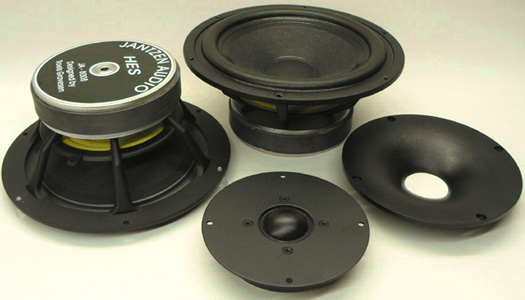

Designing your own driver is a major challenge. Having worked with hundreds of different drivers, you eventually come to a point where you would like to design your own driver, hopefully fulfilling a wide range of desired features. Some people may think that cost is a major constraint here, but it is not, unless you want to use a lot of chrome, copper and fancy metal coatings; things that do not necessarily enhance sonic performance. Metal for the motor system, magnets, chassis, voice coils, cones and surrounds basically cost very little. The problem is to get the parts you want - and in the quantities you want. If you order 10,000 units, no problem. Smaller quantities are trouble. Obviously we're not ordering thousands of units here. That would be financial suicide. The driver presented here is not designed to be a commodity product, rather a carefully designed high-end product aimed at people enjoying low-wattage, high-class amplification, but it can obviously be connected to any high-quality system. Be prepared it will reveal possible deficiencies in the system driving the speakers. Be also prepared that it will urge you to use the best crossover components available like those seen below.
Designing a driver is all about compromises! It's no problem increasing sensitivity 3, 6 or even 9 decibels. You can cut down on membrane weight, increase magnet size, use low-mass suspensions, use short voice coils, etc. But there are prices to pay for each step you take in these directions. Thin cones = risk of cone break-up, increased colouration and lack of detail; short voice coil = low Xmax (reduced cone movement), mega magnets = risk of frequency response steadily rising towards higher frequences, etc.
We may want our magnet system to accelerate our membrane instantaneously - but we need the poor thing to stop again - we need damping. I've experienced modern drivers where all measures were taken to increase acceleration and the result was severe peaking towards higher frequences, making crossover construction very difficult, and most unfortunate, the driver had severe ringing due to non-optimised suspensions, very noticeable on e.g. piano notes. The mechanical damping of any driver is extremely important and we have only two things at hand here: The spider and the surround. These devices have to keep the voice coil correctly in the magnet gap and the membrane centered correctly in the chassis. They must have the right elasticity to allow the membrane to move freely within Xmax and they must have correct resilience to quickly restore rest position when no voltage is applied. Resilience is the rate at which a system returns to a single steady state following an agitation.
The cone material, shape and mass are obviously important parameters. From the onset of the project there was no doubt in my mind that it had to be paper. Paper cones have been around since Rice and Kellogg and it's another wonder that wood pulp can me moulded into thin curvilinear membranes, providing proper strength and internal damping at the same time. Make them more rigid and they'll have nasty break-ups or make them softer and they'll compromise the ability to reveal details. The paper pulp here is mixed with long cotton fibres to provide the right balance between cone strength and internal damping. Given the right fibre composition, we don't have to coat the membranes at all. Coating is usually modern chemical polymers like PVA glue, which will dampen cone break-up, ad mass and reduce sensitivity. Coatings are sometimes applied to cover basic imperfections in cone composition and geometry. And sometimes coatings can be so thick that we have to ask whether we're listening to a paper cone or a cone made from glue. But don't get me wrong here; any pulp cone will hold a certain amount of glue to keep the fibres together and coating can do a lot of good and produce great results. The SS 18W/8530 is an example of a (sliced) paper cone added a very thin coating that does very little to what can measured - but nevertheless changes the sound significantly. Takes away some of the snappyness compared to the uncoated brother.
Considering the basic simplicity of dynamic drivers, it's a wonder we can make these things sound so great. I mean, good drivers can cover more than 6 octaves of musical information. Remarkable.
I wanted an 8" driver that could handle 40-3000 Hz without severe cone break-up, the 300-1500 Hz region at 94-95 dB/2.8 volts and an 8 ohms voice coil, providing a proper load for even single ended triode amplifiers. I also wanted SEAS in Norway to make this driver due to general excellent build quality, being Premium or EXCEL. So, with help from Bjoern Idland at SEAS, the driver seen here was constructed. The driver reaches up to 5.5 kHz, one octave above intended point of crossover, and this without noticeable peaking, allowing simple crossover construction. I couldn't have asked for more. View frequency response in measurement section.
So, why an 8 inch driver? Why not 6" or 10"? Well, I'm sure the 8" driver in an arbitrarily derived ideal size for a dynamic driver. The best balance between bass extension, sensitivity (cone mass) and high-frequency extension. And most important: I've always found an 8" driver to provide the best reproduction of the human voice - and that goes for both male and female voices. Looking back, we often find radio studio monitors build around 8" drivers, being Supravox in France, greencones in Germany, the BC1 in the UK, etc. Numerous others could be mentioned.
I've often found drivers with foam surrounds superior in performance compared to drivers with rubber surround. I've changed quite a few drivers' surround from rubber to foam and always found an increase in transient attack and sensitivity, generally a more vivid sound without compromising the drivers' frequency response. Sometimes the frequency response was even improved. Foam surrounds are very lossy and have very low mass compared to rubber and often foam will provide 1-2 dB increase in sensitivity. As a rule of thumb, the main part of the total mechanical resistance should come from the spider, not the surround and the cone may bend from pushing towards the surround being either rigid or having high mass. This is in particular important when we are dealing with lightweight cones. Thus we usually see high-efficiency drivers having either foam or corrugated paper or fabric surrounds, the latter usually coated to preserve the fragile paper and for fabric to make them airtight.
Modern foam surrounds come with built-in UV resistance and with this driver we have further added UV protection from applying a thin black polymer coating. Extensive accelerated UV tests are ongoing, where foam surrounds coated with numerous different compounds are being tested by exposure to strong UV radiation, many times the normal level coming from the sun. Ongoing, because the control sample without coating hasn't even started deteriorating yet after one year. So we feel confident that you will have a driver for years and years to come.
Break-in: As is often the case with high-efficiency drivers, the JA8008 takes some time to break-in before fully rendering its maximum performance, i.e. bass extension. After approx. 100 hours of use over a three-month period, Fs was reduced from 50 to 42 Hz. This from an average of 4 drivers under test. So, be patient after initial set-up.


The finished JA8008/TW034 speakers.
I had a mail after finishing the construction and when I first read it, I thought the guy was kidding: "Would you please describe your feelings about JA8008 driver? It looks like you're writing much more emotional about vintage speakers and this driver is only "one from many" for you. Am I mistaken here?"
My answer:
The JA8008 is my blood, sweat and tears! My desert island speaker system! More than one year of dedicated work. I was my idea to lauch a high-efficiency 8" driver for low wattage valve amps because there aren't that many around. This was definitely not just "another job" from Jantzen Audio. But I see you are right. I went through my files and I've been so busy telling about all the things going into making a driver and a speaker system, I've forgotten to write something about the system itself and how it performs. Like anything in life, we need emotion, feelings, enthusiasm, etc. I'll see if I can get it on paper. This is the worst part without falling into the ditch of stereotype self-praise and despite the impossible task of describing sound.
The "problem" with high-efficiency speakers (HES) is that people need to spend time reading - actually reading a lot of stuff - about what HES is, what they can do and what they sometimes cannot. People have to realise the relation between size, efficiency and low-end extension to make a qualified judgement of their needs before deciding what to buy. We must realise that the companies offering 96 dB in a 40 litre cab do not tell these speakers do not play much bass below 60 Hz. We need to think hard if we want to pursue the delicacy of low-wattage triode amps and the subsequent need for high-efficiency speakers. Please read: http://www.troelsgravesen.dk/HES.htm & http://www.troelsgravesen.dk/HES_II.htm
The HES & HES-II articles are the pre-work going into the JA8008. In particular HES-II. The old SEAS CA21REX driver was the one that got it all started, and if you have a project ongoing for almost 1½ year, you simply cannot manage the constant level of the emotional exitement the writer misses. It doesn't work that way. There are times of trouble when it doesn't sound right and times of joy when things work out right.
I've tried to make an overall balanced sound from the JA8008/TW034. Compared to all other speakers I've made, the area where this speaker differs the most is in its ability to reveal musical transients. The speed and attack it can produce is something none of all the other speakers on this website can manage. It's fast, very fast. A drum solo will kick butt, even from a 10 wpc amplifier.
The midrange is special because it comes from a large membrane and it's easy to hear - and understand - what singers sing. This is important if you listen to lyrics in a foreign language, which I mostly do. This speaker can reproduce vocals; it can even play vocals loud without noticeable distortion. I've made distortion measurement and even up to 110 dB @ 1 metre distance it's mostly dominated by 2nd order distortion at low levels. No nasty distortion peaks anywhere.
The bass is different from most vented systems because it's "short". Comparatively it's short and dry like bass from a properly constructed closed or aperiodic box.
The aim of this project was to create a speaker system that could compete with high-efficiency 8" full-range drivers, but without the shortcomings of whizzer cones neccessary in this category. I believe a properly engineered crossover offers significant advantages over the compromised dream of having a single diaphragm doing it all. And I think I've got it. There's no "midrange shout"; there's no 10 dB treble peaks you can't stand in the long run and there's an overall balanced presentation from the ever so important midrange, important for making instruments and vocals sound right. And there's an even power response over a wide area, something we can never accomplish from an 8" fullrange driver.
I have to include some comments on the large dome tweeter and not least the waveguide used for making an overall smooth transition from upper mid to lower treble. Having a large radiating area combined with a waveguide, providing both acoustic amplification, proper dispersion and reduction in distortion are all key elements in the smooth treble presentation. Treble os often regarded as "something above 3 kHz", which is really not true. It starts much earlier and proper integration of drivers is the key element in any successful construction. Forget any other non-waveguide standard dome tweeter for the JA8008. It's been tried and it doesn't work. Not even the most exotic and expensive tweeters could handle what this large dome can do.
Tweeter for JA8008
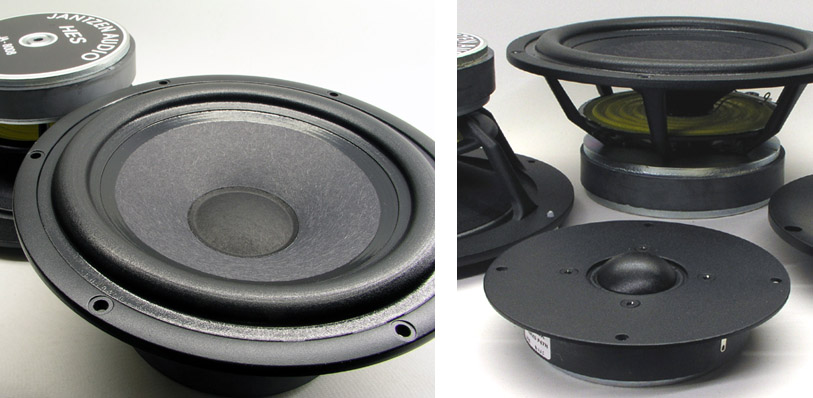
Sourcing a tweeter to match a 95 dB driver was quite a problem, because there simply aren't many around. I didn't want to use horns and ribbons. Horns are too directional and ribbons have been tried and didn't integrate well. Some recent Vifa, Peerless, ScanSpeak and SEAS tweeters have decent sensitivity, but rarely above 92 dB/2.8 volts. I didn't want a "naked" tweeter; I wanted a tweeter with a modest waveguide because they usually integrate so much better with the midrange due to reduced distortion at point of crossover and an even power response. For a system tuned to 94-95 dB sensitivity we do not necessarily need an e.g. 95 dB/2.8V tweeter. Usually the crossover will raise the sensitivity a little, but still this isn't enough.
Adding a waveguide to a dome tweeter will - if well designed - raise sensitivity 4-6 dB in the 2-8 kHz range, but also lower on-axis response above 10 kHz. Most 1" soft-dome tweeters are fairly directional above 10 kHz and applying a waveguide will often produce a more even power response, hence reduce on-axis response above 10 kHz.
Initially the vintage JBL LE26 tweeter, fitted with a waveguide, was used and performed very well, but the LE26 is obviously not a viable option, as it is no longer produced and only found on eBay.
The Dynaudio Esotar was tried, the Monacor DT300 + waveguide, Vifa XT25TG + waveguide, one of the new SEAS EXCEL tweeters, etc., but none of these were as good as the JBL LE26 + waveguide. Nor were the SEAS high-efficiency tweeters T29CF001/002. All very good tweeters, but not here.
Eventually the Audax TW034XO-P47N tweeter was tried and turned out to be just what I was looking for. A large 34 mm fabric dome driven by a huge 100 mm magnet. The TWA34 is actually a classic, having been around for many years and well known from a range of former British studio monitors. Fortunately, Audax is still producing this tweeter, now in a new and improved version. The dome area is as big as the LE26 and integrates even better than the LE26 with the JA8008 driver. By coincidence, the waveguide will fit both options should you want to experiment.
The waveguide was a new problem, as no existing waveguide will fit the TW034 tweeter. Thus we had to engage a factory dealing with CNC fabrication of everything that can possibly be made on a lathe. A huge 180 mm diameter rod of black POM plastic is stuck into the lathe and in a few minutes turned into nice looking, solid waveguides. No need here to fill cavities with damping material.
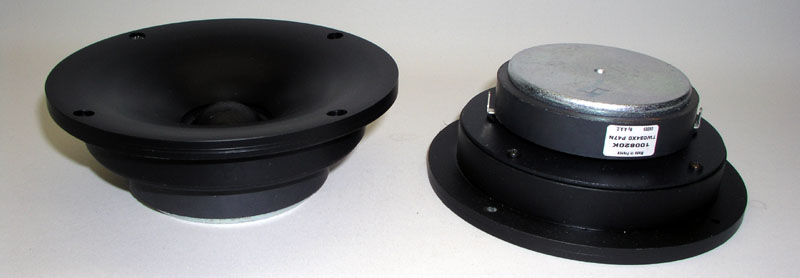
Final waveguides made from solid non-resonant POM plastic.
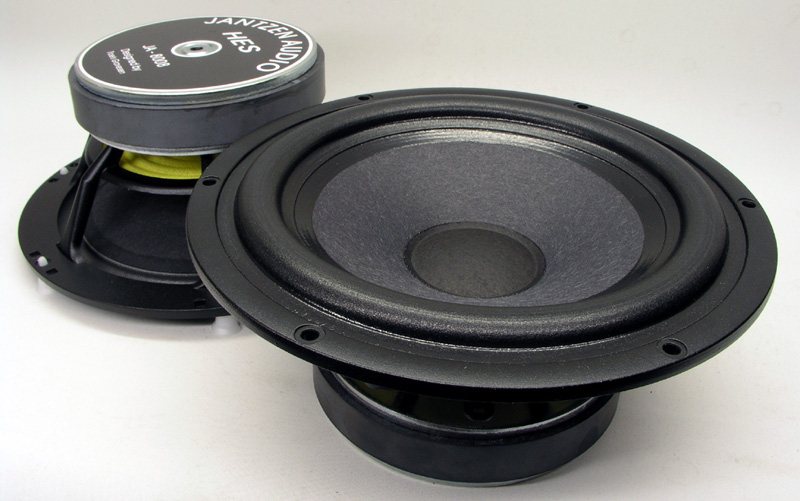
Final JA8008 production samples. Click image to download 197 KB image.
JA8008/TW034 applications
The JA8008/TW034 driver team has numerous possible applications as seen above. Not all of these have been tested yet and not all of them will be. Between us, part of product development is letting your customers find out what your product is good for and this is no exception. You simply can't make it all.
From left:
TQWT: This cabinet is the one presented on this page and is my first recommended cabinet. The system is here tuned to ~94-95 dB and provides sufficient bass for most applications. Obviously a TQWT tower can be made as seen in the second suggestion, providing a rather tall construction, but with no bends to the tube.
To learn more about transmission line speakers and TQWT cabinets (tapered-quarter-wave-tube) I suggest reading here at Martin J. King's website: http://www.quarter-wave.com/.
If the tube is tapered it's a horn, in this case a conical horn, and horns may come in all shapes and sizes depending on actual application, from the deepest bass to the highest treble.
The DOUBLE TQWT is my second project and suitable bass drivers are in place, Beyma and Pioneer. Minimum impedance can be maintained at 6 ohms from connecting bass drivers in series. What has been my prime target here is not to have a high-pass filter on the front driver. The JA8008 takes decent cone excursion and supplemented by two 10" bass drivers the overall performance is significantly enhanced compared to the TQWT. The price to pay for this is size. 150 litres brutto volume is what it takes - but what a sound!
The BR is a possible third project and requires a series coil bypassed by a resistor to allow proper tuning of a 50-60 litres vented box. The result is 92-93 dB sensitivity and 8-9 ohms impedance. Your valve amp will like this even more.
The ONKEN sketch is showing a well-know application, utilising a 12-15"/95-96 dB bass driver in a 80-160 litres cabinet with vertical front vents. The JA8008/TW034 is on top in either a vented box, a closed box or an open baffle as is often seen. Due to the high efficiency of the JA8008/TW034 duo, the use of electronic crossovers may be worth pursuing here with a point of crossover from 100-250 Hz depending on actual driver set-up.
OPEN BAFFLE: The JA8008/TW034 has been tried on an open baffle supplemented by a high-efficiency 12" driver and performs very well. Usually we would use a high-Qt driver for a single-driver/open baffle set-up, but having a high-Qt/12-15" bass driver handling the very low end, the use of a mid-driver with a low electrical Q is an advantage due to the high damping factor of the magnet system. Low Qt = reduced ringing and improved transient response. No need here for the JA8008 to compete with the bass driver.
TQWT Cabinet for JA8008
As discussed in detail in the HES article, the price for high efficiency plus low-end extension is size. However, the choice of driver size and basic parameters for the JA8008 allows a modest cabinet size; that is if you think 80 net litres is a fair price to pay for 94-95 dB sensitivity and 40-45 Hz bass extension. We are not going to claim 98 dB sensitivity and 25 Hz bass extension from an e.g. 55 liter cabinet like some manufactures will do, because it doesn't exist.
Producing proper bass extension from a 50-60 litres vented construction, requires a series coil by-passed by a resistor reduce sensitivity to 92-93 dB/2.8V. Details will be provided.
The JA8008 performs very well in a TQWT cabinet with a modest front baffle width of 280 mm. Height is 1050 mm and depth is 380 mm. Cabinet construction is simplicity itself as can be seen from the drawing below. Front panel is 30 mm MDF and slightly chamfered. Side, top and rear panels are 22 mm MDF and the internal panel is 19 mm MDF, supported by braces between front and rear panel.
Cabinet drawing
Construction details
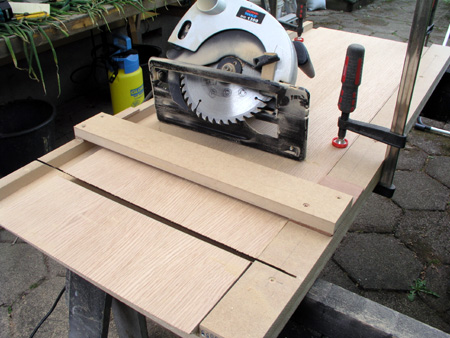
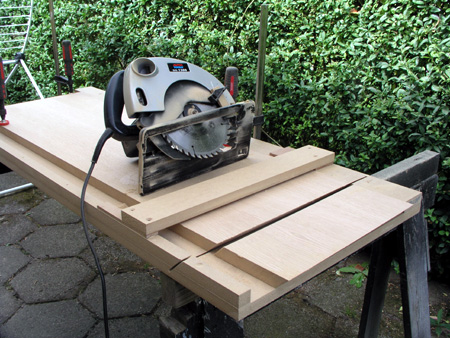
Cutting side panels at 45° angle at top.
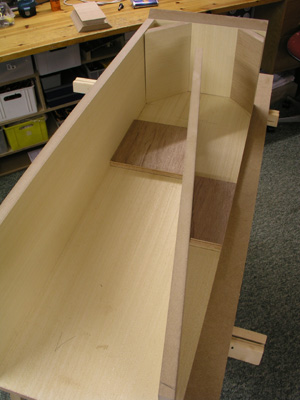
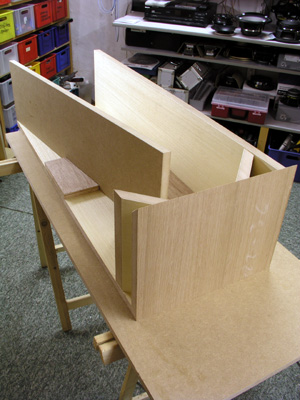
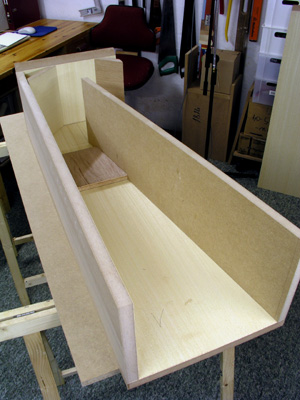
Test assembly of rear, top and side panels.
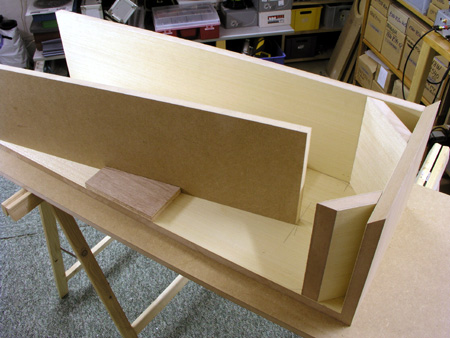
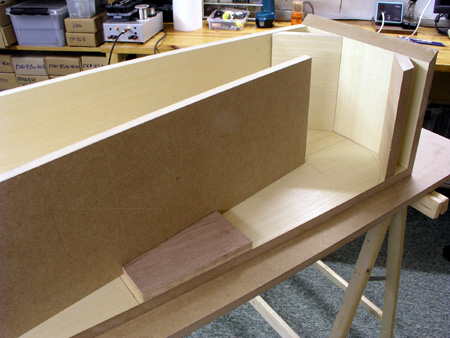
Internal panel with bracing.
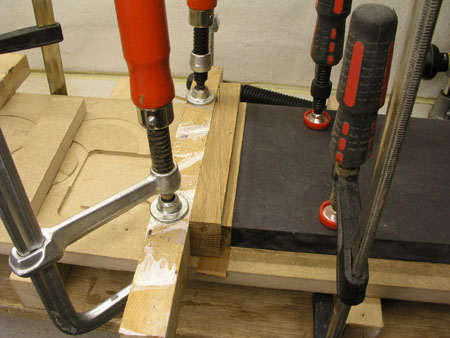
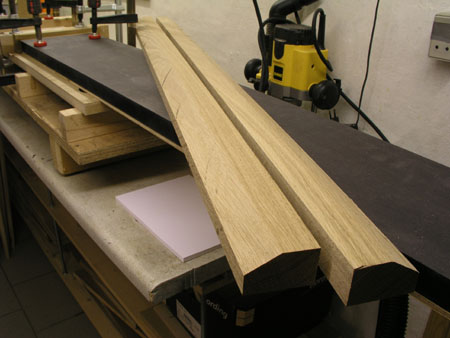
Left: Gluing top fillet to front panel. Right: Solid 30 x 50 mm oak side bars for front panel. Chamfering is 30° at half width.
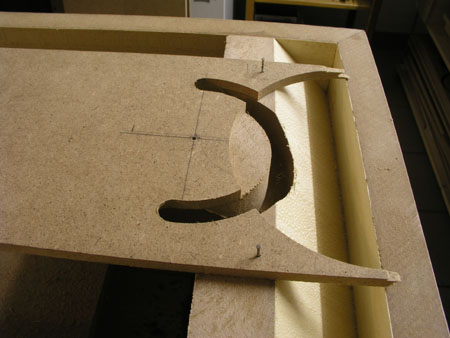
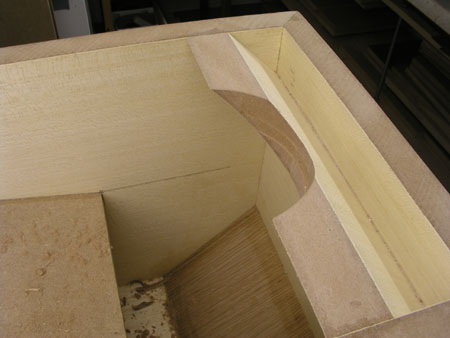
The magnet of the Audax dome needs space, thus the front reflector needs some routing.
A 105 mm outer diameter hole is made into the reflector. Route as deep as possible, break off the remains and clean with a knife.
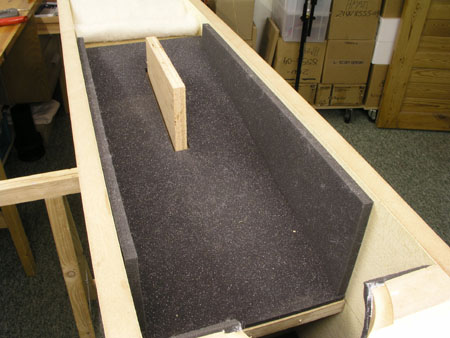
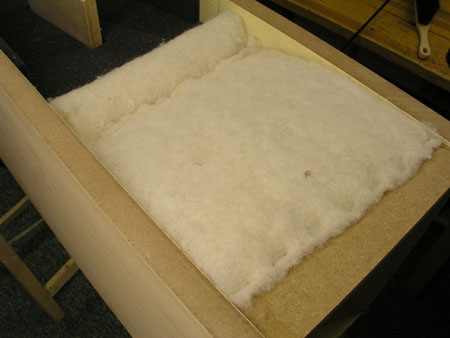
Damping material: 10 mm polyester foam and MDM3 polyester/sheep's wool (35/65) is used. No bitumen pads were used in the construction. |
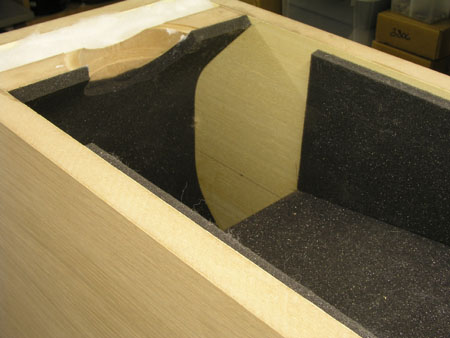
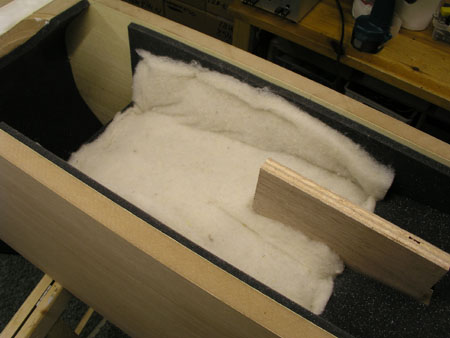
Routing for the waveguide
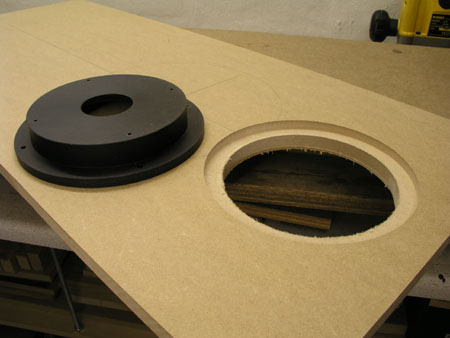
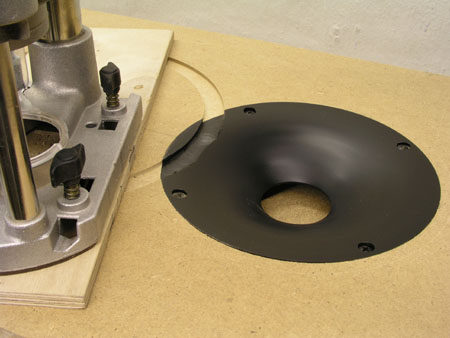
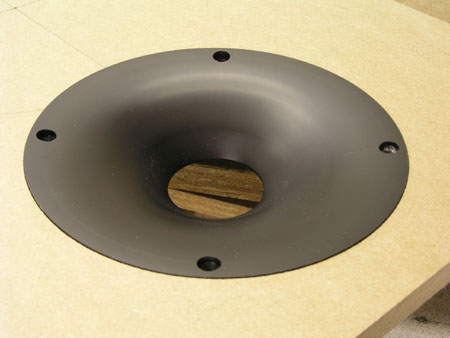
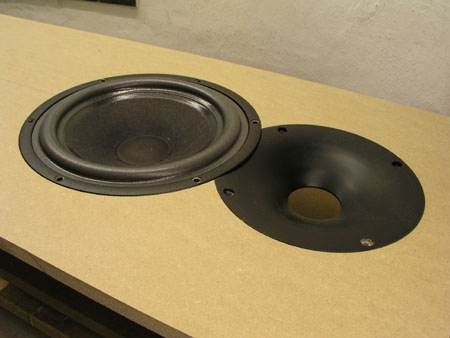
The POM plastic material has excellent properties for machining and routing into the waveguide for the JA8008 is done by slowly increasing router cutting depth; some 0.5 mm at a time. |
Fasten tweeter to waveguide

This is diy, so you have to do a little more yourself: Center the tweeter on the waveguide as seen on photo. Mark for holes on waveguide and add a 10 mm mark on the drill. Make 3 x 10 mm holes in waveguide and fasten with the screws supplied with the kit. That's it! |
Connect your drivers and secure lead wires


Secure lead wires as shown on the photos.
The TQWT Crossovers
JA8008+TW034-wg in TQWT
The low-pass section is first-order with a parallel RC-circuit to produce linear impedance. The 0.82 mH series coil is bypassed by a small RC-circuit, providing target roll-off at point of crossover. This simple arrangement together with the driver's natural roll-off provides an acoustic 3rd order topology. For the tweeter a true third-order filter produces an overall smooth frequency response and proper phase-tracking between drivers. The latter of vital importance for enhanced three-dimensionality. The chosen crossover design makes an easy 7 ohms impedance, ideal for even 5-7 watt SET amps. Due to the TQWT cabinet used, the usual bass-reflex twin-peak impedance profile is seen in the bass region, but impedance is high where phase angle (dotted line) is capacitive as can be seen from the graph below. Thus, an overall easy load on the amplifier. |
Crossover layout, Superior Z-caps.

For the final version I used Vishay metal film resitors as seen on photo.
The kit will be supplied with 10 W MOX resistors and I cannot tell the difference in sound.
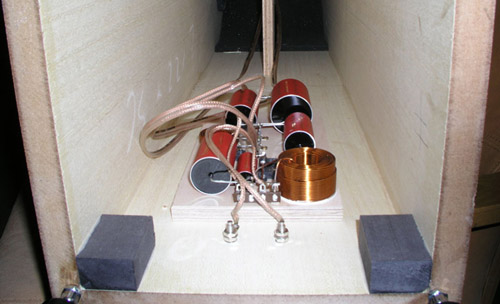
Crossover placed on rear panel.


The two most important measurements show above: |
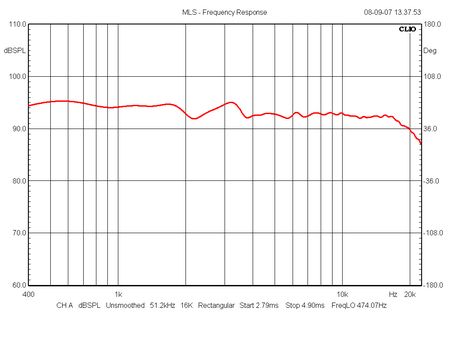
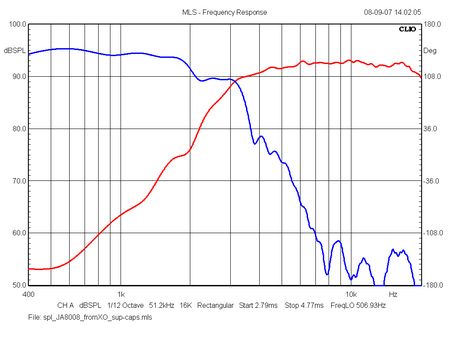
Left: Summed reponse of drivers driven from crossover. Average midrange sensitivity is 94-95 dB/2.8 V. |


Left: Impedance (red) and electrical phase (blue). |
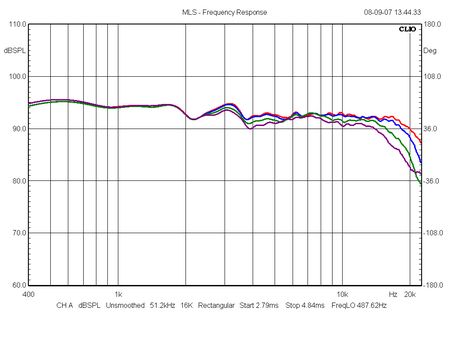
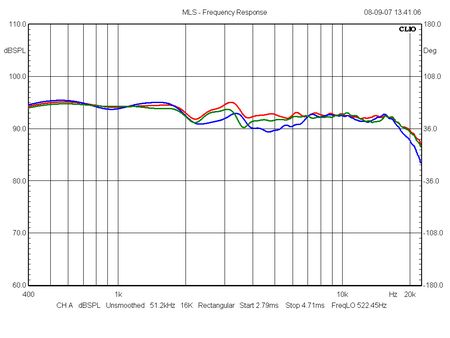
Left: Horizontal dispersion at 0, 10, 20 and 30 deg. Up to 15 kHz we have +/- 1.5 dB over a 60 deg. horizontal angle. |
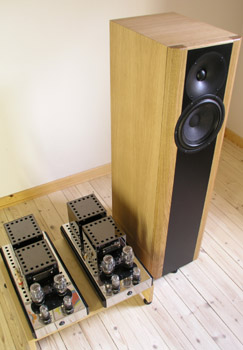
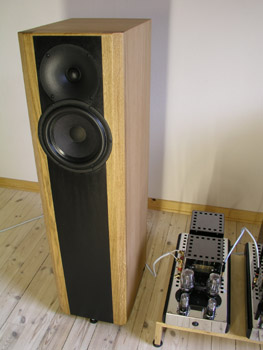






0 comentarii:
Trimiteți un comentariu